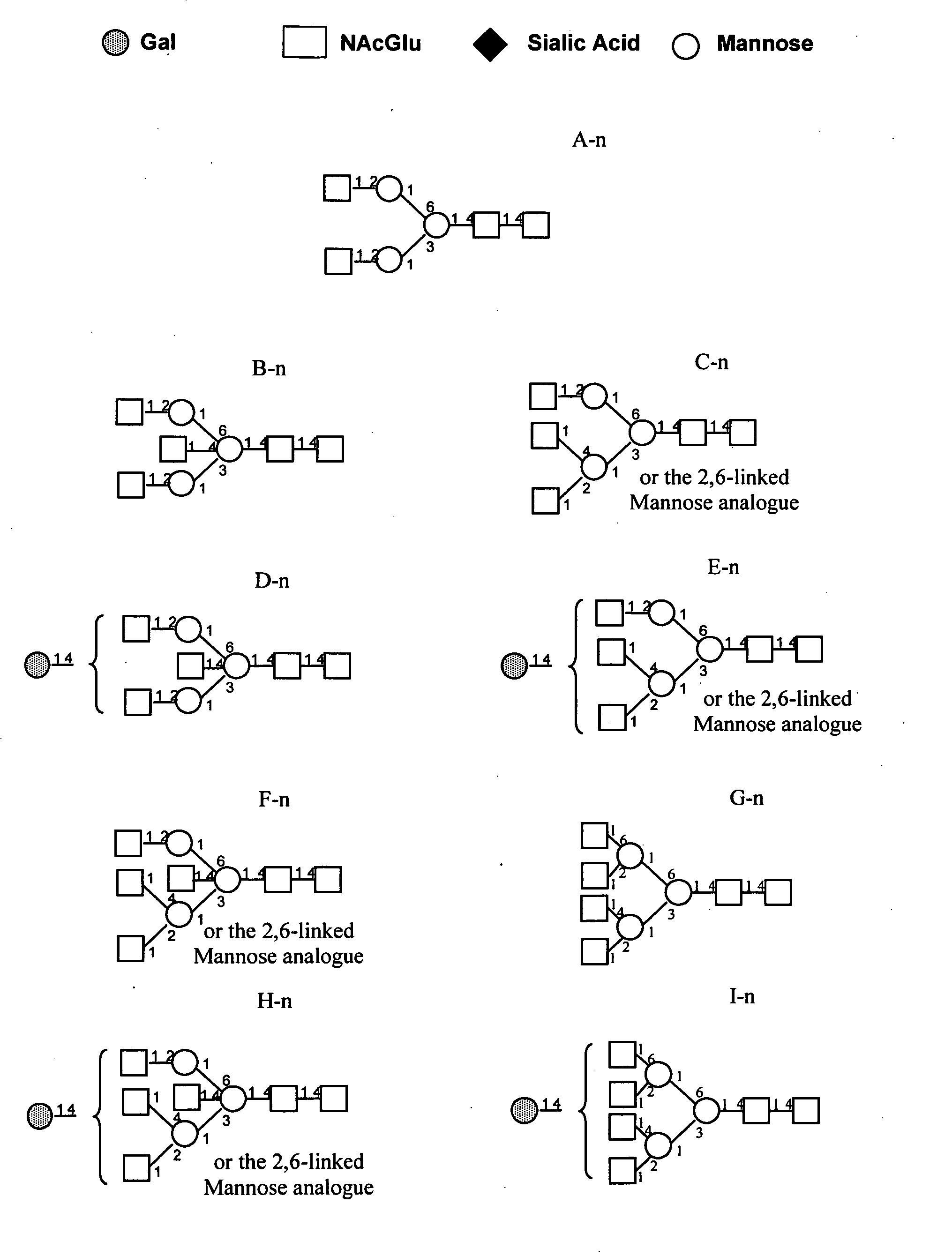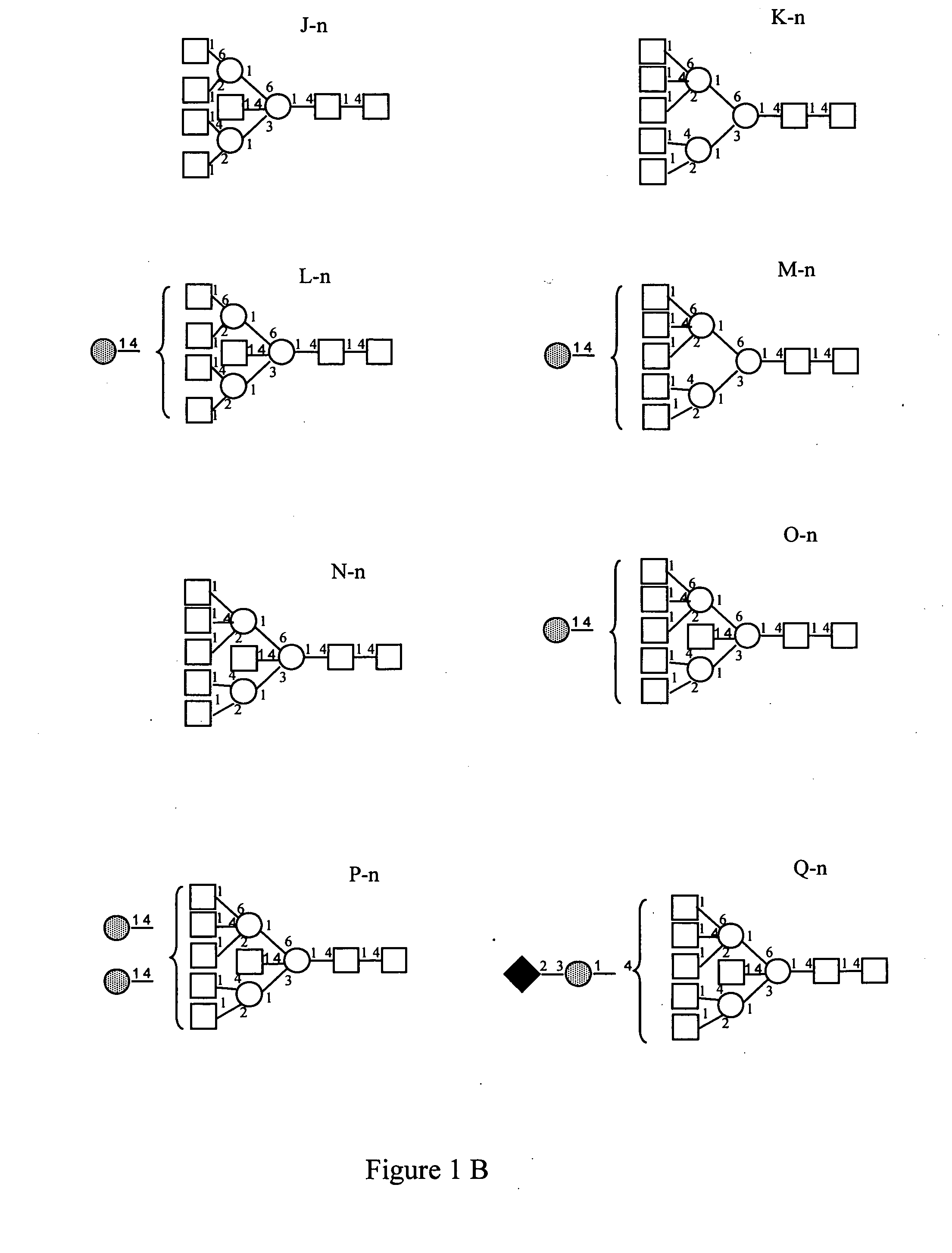Pharmacodynamically enhanced therapeutic proteins
a technology of therapeutic proteins and enhancing proteins, which is applied in the direction of drug compositions, peptide/protein ingredients, extracellular fluid disorders, etc., can solve the problems of epo having a reduced activity as a result of the attached polymer, and destroying the in vivo biologic activity, so as to prolong the biological half life and increase the biologic activity , the effect of high biologic activity
- Summary
- Abstract
- Description
- Claims
- Application Information
AI Technical Summary
Benefits of technology
Problems solved by technology
Method used
Image
Examples
example 1
Bioactivity Determination of Trangeneic Poultry Derived Human EPO by Cell Proliferation Assay
[0135]The biological activity of poultry derived EPO was assessed by an in vitro cell proliferation assay that quantifies the effect of EPO on Human Erythroleukemia (TF-1) cells. A comparison of the activity for transgenic poultry derived human EPO (TPD EPO) and human EPO obtained from recombinant CHO cells (CHO EPO) was determined and is shown in FIG. 3.
[0136]The cells were grown in RPMI-1640 medium with 2 mM L-glutamine, 1 mM sodium pyruvate, 50 mM 2-mercaptoethanol, 2 ng / ml rhGM-CSF and 10% fetal bovine serum. For 24-48 hr preceding the assay the cells were cultured in 5 ng / ml GM-CSF. The cells were then washed 3 times with cold RPMI and re-suspended in cell culture medium (without GM-CSF). The cell density of the suspension was adjusted to 1×105 cells / ml and 100 ul of the cell suspension was added to each well in a 96-well assay plate.
[0137]In a second 96 well plate, 100 uL of TPD EPO (1...
example 2
Preparation of TPD EPO Conjugated to Linear MPEG-SC-20 KDa and PK Determination
[0139]A 5.0 mM stock solution of MPEG-SC-20 KDa, purchased from Laysan Bio, Inc, Arab, Ala., was prepared in acetonitrile. A 4.7 μM stock solution of purified TPD EPO was prepared in conjugation buffer. The conjugation reaction was initiated by mixing 5 ml of the TPD EPO stock with 2.4 ml of conjugation buffer followed by the addition of 400 μl of the MPEG-SC-20 KDa stock solution resulting in a PEG:EPO molar ratio of about 85:1. The reaction was allowed to proceed overnight at room temperature. To stop the reaction, glycine was added to the reaction mix to a concentration of 20 mM, and the mix was allowed to stand for 20 minutes at room temperature. The final volume of the PEG-EPO conjugation mix was about 7.8 ml, containing about 96 μg / ml EPO.
[0140]For PK measurements approximately 200 IU of each EPO (16.7 μg of EPO) was injected into a rat. Blood samples were taken from the rat using standard methodolo...
example 3
Preparation of TPD EPO Conjugated with Linear MPEG-SC-5 KDa and PK Determination
[0141]A 2.0 mM stock solution of MPEG-SC-5 KDa, purchased from Laysan Bio, Inc, Arab, Ala., was prepared in acetonitrile. A 4.7 μM stock solution of TPD EPO was prepared in conjugation buffer. The reaction was initiated by mixing 5 ml of EPO stock with 588 μl of conjugation buffer and then adding 294 μl of the PEG stock solution resulting in PEG:EPO molar ratio of about 25:1. The reaction was allowed to proceed over night at room temperature. To stop the reaction, glycine was added to the reaction mix to a concentration of 20 mM, and the mix was allowed to stand for 20 minutes at room temperature. The final volume of the PEG-EPO conjugation mix was about 5.88 ml, containing about 129 μg / ml EPO.
[0142]For PK measurements approximately 200 IU of each EPO (16.7 μg of EPO) was injected into a rat. Blood samples were taken from the rat using standard methodologies at 4 h, 24 h, 48 h and 72 h time points. Serum...
PUM
| Property | Measurement | Unit |
|---|---|---|
| Digital information | aaaaa | aaaaa |
| Composition | aaaaa | aaaaa |
| Molecular weight | aaaaa | aaaaa |
Abstract
Description
Claims
Application Information
 Login to View More
Login to View More - R&D
- Intellectual Property
- Life Sciences
- Materials
- Tech Scout
- Unparalleled Data Quality
- Higher Quality Content
- 60% Fewer Hallucinations
Browse by: Latest US Patents, China's latest patents, Technical Efficacy Thesaurus, Application Domain, Technology Topic, Popular Technical Reports.
© 2025 PatSnap. All rights reserved.Legal|Privacy policy|Modern Slavery Act Transparency Statement|Sitemap|About US| Contact US: help@patsnap.com



